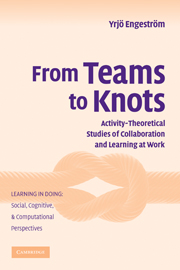Book contents
- Frontmatter
- Contents
- Series Foreword
- Preface
- 1 Teams and the Transformation of Work
- 2 Disturbance Management and Masking in a Television Production Team
- 3 Teamwork between Adversaries: Coordination, Cooperation, and Communication in a Court Trial
- 4 Displacement and Innovation in Primary Care Medical Teams
- 5 Crossing Boundaries in Teacher Teams
- 6 Knowledge Creation in Industrial Work Teams
- 7 Teams, Infrastructures, and Social Capital
- 8 From Iron Cages to Webs on the Wind
- 9 Knotworking and Agency in Fluid Organizational Fields
- References
- Author Index
- Subject Index
- Titles in the series
7 - Teams, Infrastructures, and Social Capital
Published online by Cambridge University Press: 05 June 2012
- Frontmatter
- Contents
- Series Foreword
- Preface
- 1 Teams and the Transformation of Work
- 2 Disturbance Management and Masking in a Television Production Team
- 3 Teamwork between Adversaries: Coordination, Cooperation, and Communication in a Court Trial
- 4 Displacement and Innovation in Primary Care Medical Teams
- 5 Crossing Boundaries in Teacher Teams
- 6 Knowledge Creation in Industrial Work Teams
- 7 Teams, Infrastructures, and Social Capital
- 8 From Iron Cages to Webs on the Wind
- 9 Knotworking and Agency in Fluid Organizational Fields
- References
- Author Index
- Subject Index
- Titles in the series
Summary
In Chapters 3 and 4, I developed and used the concepts of coordination, cooperation, and communication to characterize the different modes of interacting and relating to the object in teams. In Chapter 5, I expanded the picture with the concept of boundary crossing. Cooperation, communication, and boundary crossing seem to be productive but fairly short-lived episodes of innovative interaction. What all these concepts are missing is stability. Now it is time to ask: Can teams develop and sustain some sort of durable capability to interact and solve problems in a productive and proactive manner? In other words: What could be the nature of social capital in teams?
I define social capital as the glue that makes communities more than the sum total of their individual members. Social capital is a collective good, not the private property of those who benefit from it. I take a sociocentric view that focuses on what makes communities work. In other words, I search for factors that enable collective actors to sustain themselves, to perform beyond routine expectations, and to reorganize themselves when needed.
My thesis is that social capital should not be understood exclusively as intangible network relations between actors, or as equally intangible norms, values, beliefs, or mental processes. I suggest that social capital is firmly rooted in and practically inseparable from certain types of tangible material structures and artifacts – including the materiality of human beings as bodily actors.
- Type
- Chapter
- Information
- From Teams to KnotsActivity-Theoretical Studies of Collaboration and Learning at Work, pp. 169 - 181Publisher: Cambridge University PressPrint publication year: 2008



